15 Employee retention challenges in 2025 and how you should tackle them

Imagine you’re running a high-stakes relay race, and your star runner decides to drop the baton mid-race. No warning, no explanation—just a quick exit off the track. Frustrating, right? That’s exactly what it feels like when a key employee leaves unexpectedly. The rest of the team scrambles to fill the gap, momentum slows, and you’re left wondering what went wrong.
In today’s workplace, employee retention feels like that relay race. With rising competition and shifting workforce expectations, businesses are losing talent at an alarming rate. But unlike a race, where you can’t rewind the clock, organizations have the chance to pause, reflect, and fix what’s broken.
Before the talent baton slips from your hands, let's see why employees leave—and what you can do to keep them firmly on your team.
Blog Highlights


What is employee retention: Why should you care about it?

Employee retention refers to the ability of an organization to retain its employees and prevent them from leaving. It is a critical aspect of human resources management that holds immense importance for several reasons.
Stability
First and foremost, employee retention directly impacts an organization's stability and productivity. High turnover rates result in the biggest employee retention problems and in the loss of valuable talent, leading to costly recruitment and training processes. Moreover, frequent turnover disrupts workflow, affecting team dynamics and ultimately, the quality of products or services delivered.
Positive culture
Secondly, employee retention is essential for maintaining a positive company culture. When employees feel valued and secure in their roles, they tend to be more engaged and motivated. This, in turn, boosts morale, fosters a sense of loyalty, and encourages a collaborative and innovative work environment.
Cost savings
Furthermore, retention of remaining employees is closely linked to cost savings. The expenses associated with hiring and onboarding new employees can be significantly reduced by retaining existing ones. Additionally, long-term employees tend to become more skilled and efficient in their roles, contributing to increased productivity and profitability.
Improved employee morale
Thirdly, high employee retention contributes to improved morale within the organization. When employees see their colleagues staying with the company long-term, they feel a sense of stability and confidence in their own positions. This can lead to increased job satisfaction and a more positive overall atmosphere in the workplace.
Knowledge retention
Fourthly, employee retention is crucial for retaining institutional knowledge within the organization. Long-tenured employees possess valuable insights, experience, and expertise that cannot be easily replaced. By keeping these individuals on board, companies can maintain continuity in their operations and avoid the loss of critical knowledge.



Start the retention process when the person is still open to staying and not after they’ve already told you they’re leaving.
Executive Chairman
What has the biggest impact on employee retention?

Several factors influence employee retention, but one that consistently stands out as having the biggest impact is effective leadership and management. Employees don't leave companies; they leave bad managers. Let's talk about this and other factors that contribute to valuable talent leaving orgs:
- Supportive and competent leadership: Skilled and supportive leaders foster a positive work environment. They provide clear communication, guidance, and mentorship, helping employees feel valued and motivated.
- Recognition and feedback: Managers who regularly acknowledge their team's efforts and provide constructive feedback create a sense of appreciation. This recognition boosts morale and job satisfaction – key factors in retaining employees.
- Career growth opportunities: Strong leaders help employees understand their career paths within the organization. They actively work on developing their team, offering opportunities for advancement and skill development.
- Conflict resolution: Effective managers address workplace issues promptly and fairly. By resolving conflicts and maintaining a harmonious atmosphere, they ensure employees feel comfortable and supported.
- Work-life balance advocacy: Good leadership respects and encourages work-life balance. This not only reduces burnout but also enhances the employee experience, well-being and retention.
- Creating inclusive environments: Leaders play a crucial role in fostering diversity and inclusion. A diverse and inclusive workplace is appealing to employees, increasing their commitment to the organization.
- Emotional intelligence: In addition to competency, leaders with high emotional intelligence are better equipped to understand and empathize with their team members' needs and concerns.
- Training and development initiatives: Leaders who prioritize investing in training and development initiatives demonstrate a commitment to their employees' growth and success.
- Transparent communication: Effective leaders practice transparent communication, keeping their team members informed about important decisions, changes, and company goals.
- Competitive compensation and benefits: Offering competitive compensation packages and attractive benefits demonstrates appreciation for employees' contributions and helps retain top talent.
- Workplace culture: A positive and inclusive workplace culture, cultivated by leadership, contributes significantly to employee retention. A culture that values respect, collaboration, and innovation fosters employee engagement and loyalty.
What are the 3 R's of employee retention?

The "R's" of employee retention are three robust pillars are the secret recipe for organizations looking to retain their exceptional talent viz. – Recruitment, Recognition, and Reskilling. We’ll dive deep into each "R," unraveling the strategies and insights that will reshape your approach to employee retention.
1. Recruitment
This involves hiring the right people from the start. A thoughtful and comprehensive recruitment process ensures that candidates who align with the company's culture and values are brought on board. By recruiting talented employees, who are a good fit, you increase the chances of long-term retention.
2. Recognition
Recognition is all about acknowledging and appreciating your employees' hard work and contributions. Regular recognition, whether through verbal praise, awards, or other forms of acknowledgment, boosts morale and job satisfaction. Feeling valued is a powerful motivator for employees to stay with their current employer.
3. Reskilling
Reskilling refers to the process of providing employees with opportunities to learn new skills and grow within the organization. As the business landscape evolves, employees want to know that they have a future and are continually developing.
Investing in reskilling not only improves their job satisfaction but also makes them more adaptable and valuable to the company, increasing employee retention and important move rates.
These three R's form a crucial framework for fostering a work environment that attracts and retains top talent while ensuring that existing employees remain engaged and motivated in their roles.



If you can engage people and work around their needs, you can improve loyalty and retention and, save money on recruitment costs.
CEO
Tiger Recruitment
How high turnover impacts a company's productivity and culture?
High employee turnover disrupts organizational dynamics, negatively affecting both productivity and workplace culture. The repercussions extend beyond operational inefficiencies to deeply impact team morale and long-term goals.
- Decreased team cohesion: Frequent departures break team continuity, making it harder for remaining employees to maintain effective collaboration. Teams must constantly adapt to new members, slowing progress on projects.
- Increased workload for remaining employees: When employees leave, their responsibilities are often distributed among existing staff, leading to burnout. Overworked employees may experience reduced engagement, further affecting productivity.
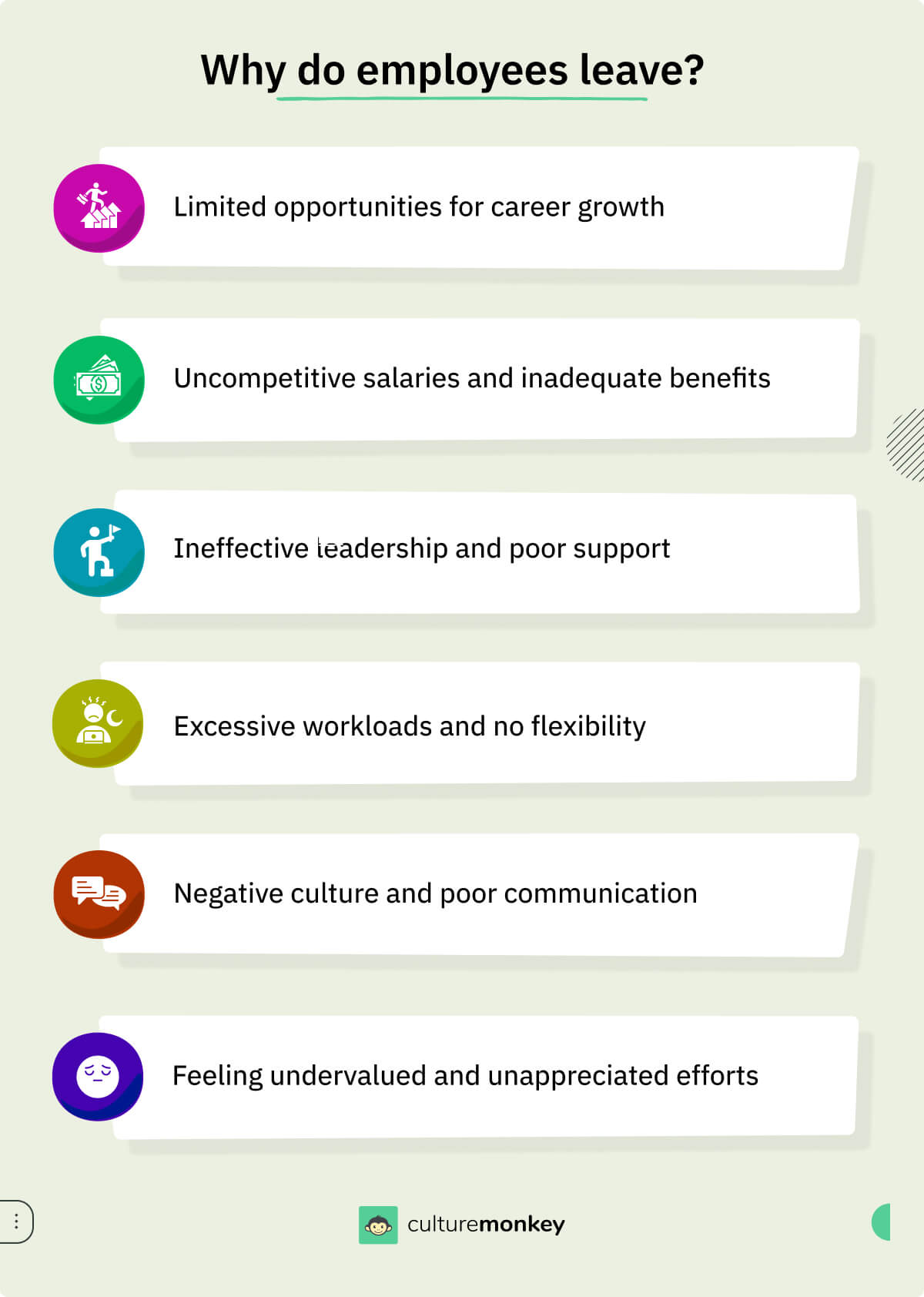
- Loss of institutional knowledge: Departing employees take with them critical knowledge and expertise accumulated over time. This knowledge gap can disrupt workflows and lead to costly mistakes.
- Extended onboarding periods: Recruiting and onboarding new hires takes time, during which overall productivity declines. New employees need months to reach the efficiency of their predecessors, delaying key deliverables.
- Negative employer brand perception: High turnover signals instability to current employees and external stakeholders. This can damage the company’s reputation, making it harder to attract top talent in the future.
- Erosion of workplace culture: A revolving door of employees undermines efforts to build a cohesive workplace culture. Long-term employees may feel disconnected or question the company’s commitment to its workforce.
- Reduced innovation: Teams experiencing constant disruption may struggle to foster creativity and innovation, focusing instead on filling gaps and maintaining basic operations.
What are the six factors influencing employee retention?

Cracking the code on employee retention can boil down to six distinct factors that influence it. We'll explore these six pieces of the puzzle and give you some practical ideas to make your workplace a better and happier one. It's all about creating a place where employees want to be and where they can flourish.
1. Compensation and benefits
Competitive pay and comprehensive benefits packages are paramount. Employees need to feel fairly compensated for their contributions, including bonuses, health benefits, and retirement plans.
2. Work-life balance
Maintaining a healthy balance between work and personal life is increasingly crucial. Organizations that support flexible schedules, remote work options, and paid time off create environments where employees are more likely to stay.
3. Career growth opportunities
Employees seek continuous professional development opportunities and growth. Providing clear career paths, mentorship programs, and opportunities for skill enhancement instills a sense of purpose and longevity.
4. Company culture
A positive company culture where values align with those of employees promotes a sense of belonging and an employee engagement solutions well. Team-building activities, social events, and open communication contribute to a thriving culture.
5. Leadership and management
Effective and supportive leadership is a driving force in retention. Leaders who provide guidance, recognition, and mentorship help build trust and employee loyalty.
6. Workplace wellbeing
Employee wellbeing is paramount. Offering mental health support, wellness programs, and a safe, comfortable work environment creates a space where employees feel valued, cared for, and more likely to stay long-term.
These factors intersect and weave together to create an environment where employees not only feel content but are also eager to remain committed to their organization.
By recognizing the impact of these elements and implementing strategies to enhance them, you can create an environment where employees choose to stay, thrive, and contribute to your organization's success.
Embracing these factors is not only a smart business move but also a commitment to nurturing a workplace where your valuable and talented employees can flourish and grow, leading to a brighter and more prosperous future for your company.
7 Benefits of an employee retention program at workplace

Imagine having a workforce that not only excels in their roles but also sticks around the same job for the long haul, bringing their expertise and dedication year after year. This is precisely what an employee retention program aims to achieve!
In this discussion, we'll explore the seven compelling benefits of implementing such a program in your workplace. From boosting productivity to saving on recruitment costs, these advantages not only make good business sense but also foster a thriving and harmonious work environment.
1. Enhanced customer satisfaction
A stable and experienced workforce is more adept at delivering consistent and high-quality service, leading to increased customer satisfaction. Satisfied customers are more likely to return and become loyal to your businesses and your brand.
2. Knowledge retention
Retaining long-term employees means retaining institutional knowledge. Experienced employees possess valuable insights and expertise that are passed on to newer team members, improving overall performance and decision-making.
3. Lowered recruitment costs
Constantly replacing employees can be a significant financial burden. Employee retention programs reduce recruitment and training expenses, ensuring your budget can be allocated to other critical areas of the business.
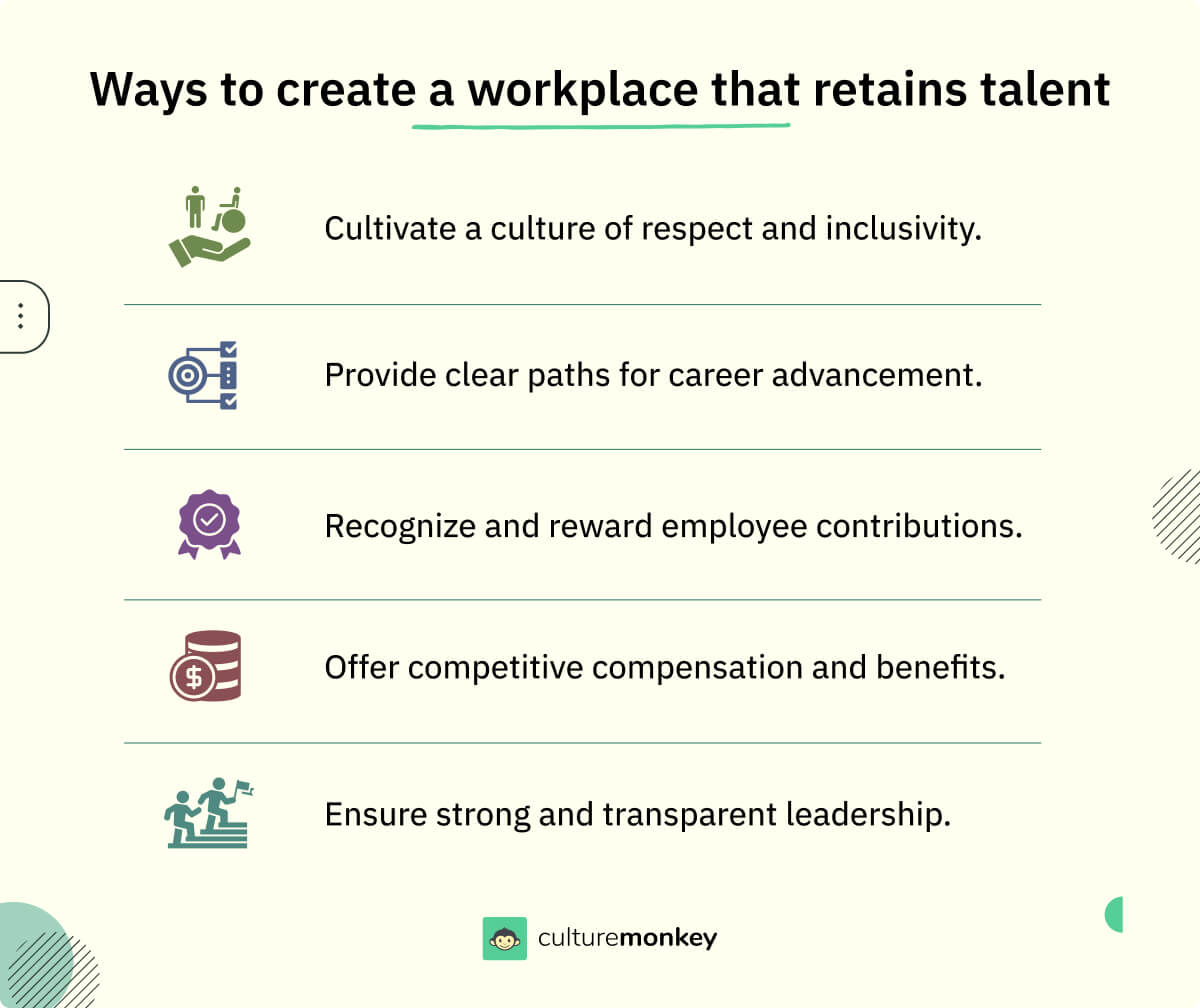
4. Higher employee morale
When employees feel secure in their roles and valued by their employer, morale improves. Higher morale translates to a more positive workplace culture, increased teamwork and employee contributions, and a greater sense of belonging.
5. Innovation and efficiency
Long-serving employees are more likely to suggest innovative ideas and improvements in processes. They have a deep understanding of the company's operations and are in a better position to identify areas for innovation and efficiency.
6. Reduced disruption
High turnover of workers can lead to disruptions in workflow, impacting productivity. Retained employees contribute to a more stable and efficient work environment, ensuring consistent operations and reduced downtime.
7. Positive brand image
A company known for retaining its employees sends a positive message to the job market. It becomes an attractive employer, making it easier to attract top talent who are eager to join an organization with a reputation for valuing and retaining its workforce.
In a world where the competition for top talent is fierce, an employee retention program can be your secret weapon for success. It's not just about keeping employees on board; it's about creating a workplace where they genuinely want to stay.
The benefits, from increased productivity to cost savings, are undeniable, making a strong case for investing in such programs to ensure a brighter and more prosperous future for your organization.
15 Employee turnover challenges examples

Let’s dive into 15 unique and pressing challenges in retaining employees that organizations face today. From the impact of the "Great Resignation" to the nuances of diversity and inclusion, each challenge poses distinct hurdles but also professional growth opportunities for companies striving to keep their talent in-house.
- Attraction of top talent: In a fiercely competitive job market, attracting and retaining top talent is a major challenge. Offering competitive salaries, perks, and a compelling employer brand is crucial to stand out.
- Remote work burnout: With the prevalence of remote work, employees often experience burnout due to blurred boundaries. Organizations must implement strategies like flexible scheduling and digital detox policies to combat this.
- Technology and automation anxiety: The fear of automation replacing jobs can cause employees to seek job security elsewhere. Companies should provide training and emphasize the value of human skills in the face of automation.
- Work-life balance: Maintaining a healthy work-life balance can be challenging, particularly in remote work scenarios. Encouraging time off, enforcing clear work hours, and limiting after-hours communication are solutions.
- Diversity and inclusion challenges: Ensuring a diverse and inclusive workplace is essential, yet many organizations struggle with discrimination issues. This can be addressed through awareness training, clear policies, and unbiased hiring practices.
- Lack of career growth opportunities: Employees want to know they have a future within the organization. Companies should provide clear career paths, invest in leadership development, and offer regular feedback to address this challenge.
- Mental health and wellbeing concerns: Mental health is a growing concern, with increasing stress levels among employees. Employers can combat this by offering mental health support programs, wellness days, and encouraging open dialogues.
- Lack of employee recognition and appreciation: Employees need recognition and appreciation to stay motivated and engaged. Recognition programs, shout-outs, and celebrating small wins can make a significant difference in retention rates.
- Inadequate training and onboarding: Ineffective onboarding and training can lead to quick turnover. Companies should revamp their onboarding processes, provide comprehensive training, and assign mentors to new hires.
- Disconnect in a hybrid work environment: With some employees working remotely and others in the office, a disconnect can occur. Employers must establish clear communication channels, encourage video meetings, and organize regular team-building activities.
- The great resignation: The "great resignation" is a phenomenon characterized by a significant number of employees quitting their jobs. Employers can address this by conducting stay interviews, seeking feedback, and making adjustments based on employee insights.
- Generational workforce gaps: Bridging the gap between different generations in the workplace can be difficult, as each group has unique expectations and work styles. Tailored engagement strategies, mentorship programs, and flexible policies can help accommodate these differences.
- Stagnant company culture: A stagnant or toxic company culture can drive employees away. Regularly assessing organizational values, promoting transparency, and fostering a collaborative environment can revitalize culture and improve retention.
- Uncompetitive benefits packages: Beyond salaries, benefits like parental leave, health coverage, and retirement plans significantly influence retention. Employers must stay updated on industry standards and tailor benefits to employee needs.
- Resistance to change: Employees may resist organizational changes, such as restructuring or adopting new tools. Providing clear communication, training, and opportunities for feedback can help employees adapt and feel supported during transitions.
Navigating these challenges is essential for organizations to thrive in 2025 and beyond. Each of these challenges offers an opportunity for growth and improvement, with the ultimate goal of fostering a workplace where employees choose to stay and thrive. So what are some ways a company can tackle them?
What are the consequences of high employee turnover?
High employee turnover can have significant consequences for organizations, affecting various aspects of operations and productivity. Here are some of the key consequences associated with high employee turnover:
- Decreased productivity: Constantly having to recruit, hire, and train new employees takes time and resources away from productive activities. This can lead to a decline in overall productivity as existing employees may need to pick up the slack or spend time assisting new hires.
- Increased costs: Employee turnover is costly for organizations. Hiring and training new employees incur expenses such as recruitment fees, onboarding costs, and productivity losses during the learning curve. Moreover, high turnover rates may require higher salaries or bonuses to attract and retain talent, further increasing costs.
- Disruption in workflow: When employees leave, it disrupts the workflow and can lead to delays in projects or tasks. Co-workers may need to take on additional responsibilities or projects may need to be put on hold until replacements are found and trained, impacting overall efficiency.
- Loss of institutional knowledge: Experienced employees possess valuable institutional knowledge and expertise accumulated over time. When they leave, this knowledge is lost, making it challenging for new hires to fill the gap and potentially affecting the quality of work and decision-making within the organization.
- Decreased morale: High turnover can have a negative impact on employee morale and engagement. Existing employees may feel overworked or demotivated by the constant turnover, leading to decreased job satisfaction and increased turnover intentions themselves.
- Damaged reputation: Persistent high turnover rates can tarnish an organization's reputation as potential employees and clients may view it as unstable or undesirable. This can make it more challenging to attract top talent and retain existing clients, ultimately affecting the organization's bottom line.
- Lower customer satisfaction: Employee turnover can also impact customer satisfaction. New employees may lack the experience or knowledge to effectively meet customer needs, leading to reduced service quality and satisfaction levels.
- Hindered growth and innovation: Constant turnover can hinder organizational growth and innovation efforts. With a revolving door of employees, it becomes difficult to establish a stable team environment conducive to collaboration, creativity, and long-term strategic planning.
What are employee retention strategies 2025?

As organizations strive to maintain a competitive edge and foster a conducive environment for talent retention, strategic initiatives have become imperative. Here are 7 employee retention strategies in 2025:
1. Embracing hybrid work models
In response to shifting paradigms induced by the global pandemic, organizations have embraced hybrid work models, blending remote and in-office work arrangements. This strategy not only accommodates diverse employee preferences but also enhances flexibility and work-life balance, thereby bolstering retention rates.
2. Prioritizing employee well-being
Recognizing the intrinsic link between employee well-being and retention, organizations have intensified efforts to prioritize mental, emotional, and physical health in the workplace. From implementing wellness programs to offering mental health days, companies are fostering a supportive environment conducive to employee flourishing and loyalty.
3. Amplifying diversity and inclusion initiatives
In 2025, organizations are doubling down on diversity and inclusion initiatives to cultivate a culture of belonging and equity.
By championing diverse hiring practices, providing inclusive training, and fostering a sense of belonging among underrepresented groups, companies are not only enhancing retention but also reaping the benefits of diverse perspectives and experiences.
4. Personalized career development paths
Acknowledging the significance of career growth in employee retention, organizations are investing in personalized career development paths.
Through mentorship programs, skill-building workshops, and tailored advancement opportunities, companies are empowering employees to chart meaningful career trajectories within the organization.
5. Leveraging technology for engagement
In the digital age, organizations are harnessing technology to foster employee engagement and connection.
From virtual team-building activities to interactive communication platforms, technology serves as a conduit for fostering camaraderie and collaboration among remote and hybrid teams, thereby mitigating turnover risks.
6. Cultivating leadership excellence
Effective leadership is pivotal in nurturing a thriving and engaged workforce. In 2025, organizations are prioritizing leadership development programs to equip managers with the requisite skills to inspire, motivate, and support their teams.
By cultivating a cadre of competent and empathetic leaders, companies fortify their retention efforts and nurture a culture of excellence.
7. Instituting flexible benefits packages
In an era marked by diverse employee needs and preferences, organizations are instituting flexible benefits packages tailored to individual requirements.
Whether it's offering customizable health insurance plans, flexible working hours, or remote work allowances, companies are aligning benefits with employee expectations, thereby enhancing satisfaction and retention.
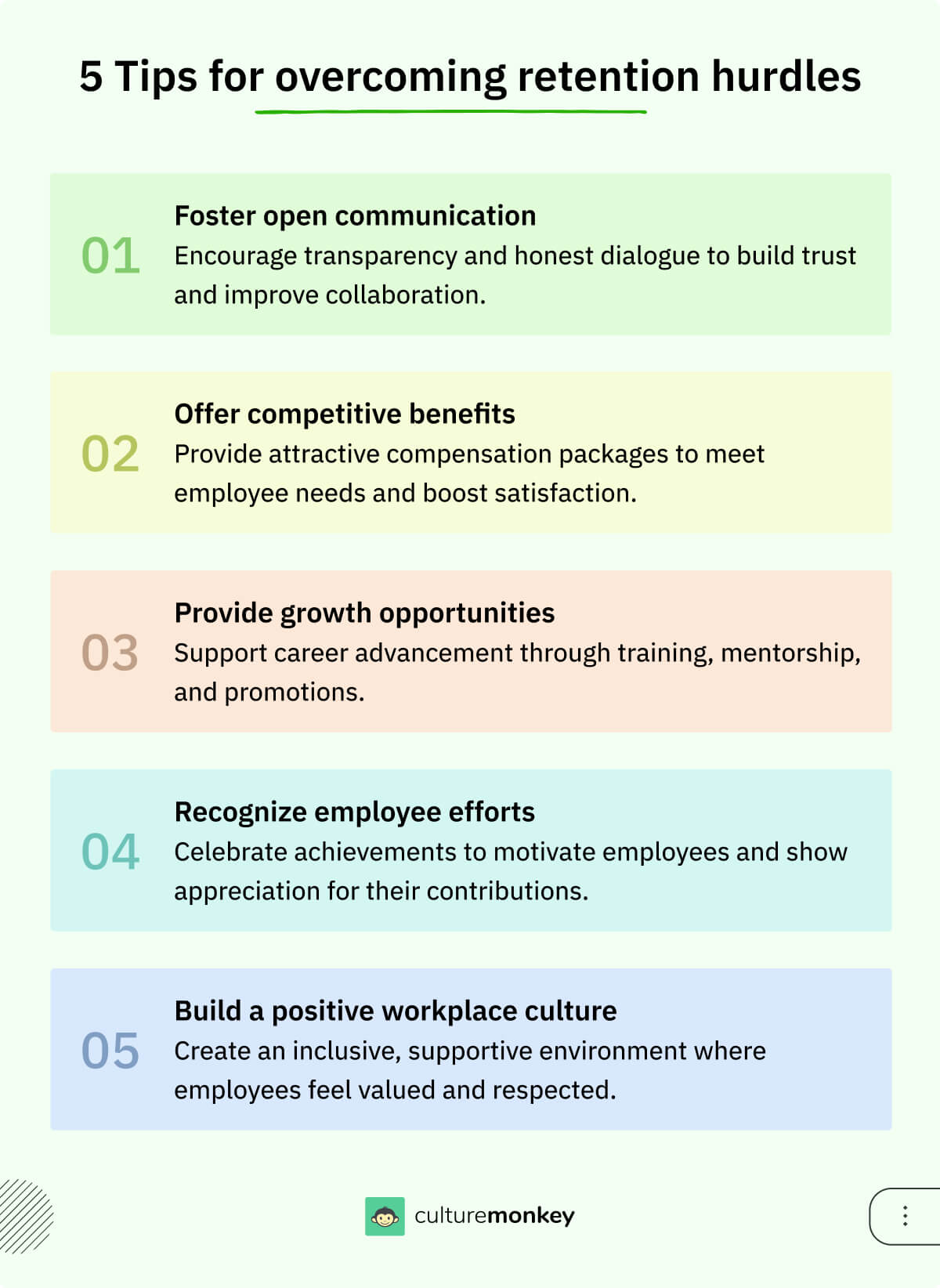
What are some signs that an employee might be considering leaving?
Recognizing signs that an employee might be considering leaving is crucial for organizations to proactively address underlying issues and potentially mitigate turnover. Here are some key indicators to watch for:
- Decreased engagement: A noticeable decline in an employee's engagement level, such as disinterest in projects, reduced participation in meetings, or lack of enthusiasm for their work, can be an early sign of potential departure. Workplace disengagement often precedes an employee's decision to leave.
- Increased absenteeism or tardiness: Employees who are contemplating leaving may start to exhibit patterns of increased absenteeism or tardiness. They may take more frequent sick days or arrive late without valid reasons, signaling a disengagement with their role or workplace.
- Decline in performance: A sudden or gradual decline in an employee's performance may indicate underlying dissatisfaction or disengagement. Missed deadlines, decreased productivity, or an increase in errors could be signs that an employee is mentally checking out and considering leaving.
- Withdrawal from social interactions: Employees who are thinking about leaving may withdraw from social interactions with colleagues or become more distant in their relationships at work. They may avoid team activities, lunch gatherings, or informal conversations, signaling a desire to disengage from the workplace community.
- Increased job-seeking behavior: Observable signs of active job-seeking behavior, such as updating LinkedIn profiles, attending networking events, or taking calls during work hours, suggest that an employee is exploring opportunities elsewhere and may be considering leaving their current role.
- Lack of interest in career advancement: Employees who no longer express interest in career advancement opportunities within the organization, such as promotions or professional development initiatives, may be signaling their intent to explore options elsewhere for career growth.
- Negative attitude or behavior: A noticeable shift in attitude or behavior, including increased cynicism, negativity, or conflict with colleagues or management, may indicate underlying dissatisfaction with the job or organization.
- Seeking feedback on market value: Employees who start asking questions about their market value, salary benchmarks, or industry trends may be evaluating their worth in the job market and considering alternative employment options.
- Sudden changes in personal circumstances: Significant changes in an employee's personal circumstances, such as relocation plans, family commitments, or financial concerns, may prompt them to reassess their career goals and consider leaving their current position.
- Lack of commitment to long-term projects: Employees who express reluctance or disinterest in committing to long-term projects or initiatives may be signaling their intention to leave before the completion of such endeavors.
How to address employee retention challenges?

Tackling these challenges in retaining employees requires a strategic and proactive approach. Here are some effective strategies to address these specific challenges and create a workplace where employees are motivated to stay:
- Attracting top talent: improve your employer brand, offer competitive compensation, and highlight your unique culture to attract and retain top talent.
- Remote work burnout: implement flexible work schedules, encourage regular breaks, and provide wellness programs to combat remote work burnout.
- Technology and automation anxiety: offer upskilling and reskilling opportunities to show your commitment to employee career growth.
- The great resignation: conduct stay interviews to understand employee concerns, actively seek feedback, and make necessary adjustments based on the insights gained.
- Employee engagement initiatives: Implementing various employee engagement initiatives such as team-building activities, social events, and volunteer opportunities can help foster a sense of belonging and connection among employees.
- Flexibility in career paths: Offering flexibility in career paths allows employees to explore different roles within the organization based on their skills, interests, and aspirations.
- Promotion of psychological safety: Promoting psychological safety in the workplace encourages employees to speak up, share their ideas, and voice their concerns without fear of retaliation or judgment.
- Investment in diversity and inclusion training: Investing in ongoing diversity and inclusion training for employees at all levels of the organization promotes awareness, understanding, and empathy toward diverse perspectives and experiences.

Retain your top talents
These 20 questions uncover key insights, address critical pain points, and help you build a workplace where employees thrive and stay committed.
The first step in addressing employee retention problems
The first step in addressing employee retention problems is to conduct a comprehensive analysis to identify the root causes of turnover within the organization. This involves gathering feedback from employees through surveys, interviews, and exit interviews to understand their reasons for leaving or considering leaving.
Once the underlying staff retention issues are identified, organizations can develop targeted strategies and initiatives to address them effectively.
This may involve implementing changes to policies, procedures, or organizational culture to better support employee needs and preferences. For example, if work-life balance emerges as a significant concern, introducing flexible work arrangements or wellness programs could help alleviate stress and improve retention.
Furthermore, fostering open communication channels between management and employees is essential for addressing retention problems.
Encouraging feedback, actively listening to employee concerns, and demonstrating a commitment to addressing issues can help build trust and enhance employee engagement and loyalty.
By taking proactive measures to understand and address the challenges of employee retention, organizations can create a more positive and supportive work environment conducive to long-term employee retention.
Top 3 companies with the best employee retention programs
Several companies stand out for their exemplary employee retention programs, demonstrating a commitment to fostering a positive work environment, prioritizing employee well-being, and investing in professional development.
Among them, three companies particularly shine for their outstanding retention initiatives.
1. Google
Google is renowned for its innovative approach to employee retention, offering a plethora of perks and benefits designed to enhance the employee experience. From competitive salaries and comprehensive healthcare coverage to on-site wellness amenities and flexible work arrangements, Google prioritizes employee well-being and work-life balance.
Moreover, Google's unique approach to career development, including opportunities for internal mobility, ongoing learning initiatives, and mentorship programs, empowers employees to chart meaningful career paths within the organization.
By cultivating a culture of inclusivity, innovation, and continuous learning, Google has successfully maintained a high level of employee satisfaction and retention.
2. Salesforce
Salesforce is recognized for its steadfast commitment to employee success and engagement, exemplified by its robust retention programs and initiatives.
Central to Salesforce's retention strategy is its focus on diversity, equity, and inclusion, manifested through initiatives such as employee resource groups, inclusive leadership training, and diverse hiring practices.
Additionally, Salesforce prioritizes employee well-being through comprehensive wellness programs, mental health support resources, and flexible work arrangements.
The company also invests significantly in employee development, offering extensive training opportunities, leadership development programs, and tuition reimbursement for continued education.
By fostering a culture of trust, transparency, and empowerment, Salesforce has cultivated a loyal and engaged workforce, resulting in high retention rates.
3. Microsoft
Microsoft's employee retention programs are anchored in a commitment to fostering a culture of innovation, collaboration, and growth. The company prioritizes employee development through a variety of initiatives, including mentorship programs, skills training workshops, and career coaching resources.
Microsoft also offers competitive compensation packages, comprehensive benefits, and flexible work arrangements to support employee well-being and work-life balance.
Moreover, Microsoft emphasizes diversity and inclusion, implementing initiatives such as unconscious bias training, diversity hiring goals, and employee resource groups to create a more inclusive workplace.
By investing in the holistic development and support of its employees, Microsoft has established itself as a leader in employee retention, with high levels of employee satisfaction and loyalty.
Measuring the impact of your retention strategies

Measuring the effectiveness of retention strategies is vital for ensuring that your efforts align with organizational goals and address employee needs. Proper evaluation helps identify successes, areas for improvement, and the overall return on investment (ROI). Here are key ways to measure retention strategy impact:
- Turnover rate analysis: Regularly calculate employee turnover rates to track trends over time. Break down the data by department, role, and tenure to identify specific areas requiring attention.
- Retention benchmarking: Compare your retention rates against industry standards to determine where your organization stands. This external perspective highlights whether your strategies are keeping pace with competitors.
- Employee engagement scores: Use surveys to gauge engagement levels before and after implementing retention strategies. High engagement typically correlates with lower turnover and improved employee satisfaction.
- Exit interview insights: Analyze feedback from departing employees to understand recurring themes behind turnover. This qualitative data is invaluable for refining retention initiatives.
- Cost-to-retain vs. cost-to-recruit: Evaluate the financial efficiency of your strategies by comparing the cost of retention efforts (e.g., training, benefits) to the cost of recruiting and onboarding new hires.
- Time-to-fill metrics: A reduction in time-to-fill vacant positions may indicate that improved retention is reducing the strain on recruitment processes.
- Performance and productivity metrics: Monitor team output and project timelines to assess whether improved retention strategies are positively influencing productivity.
The role of employee engagement solutions

Employee engagement solutions play a crucial role in fostering a positive and productive work environment, ultimately contributing to higher retention rates and organizational success.
These solutions encompass a variety of strategies, tools, and initiatives designed to enhance employee motivation, satisfaction, and commitment to their work and the organization.
One key aspect of employee engagement solutions is the implementation of regular feedback mechanisms, such as employee surveys, performance reviews, and one-on-one meetings.
By soliciting feedback from employees, organizations can gain valuable insights into their needs, concerns, and satisfaction levels, allowing them to address issues promptly and effectively.
Moreover, employee engagement solutions often involve promoting open communication and transparency within the organization.
Clear communication channels, regular updates on company goals and initiatives, and opportunities for employees to voice their opinions and ideas create a culture of trust and collaboration, fostering a sense of belonging and engagement among employees.
By acknowledging and appreciating employees' contributions, providing avenues for growth and advancement, and supporting their overall well-being, organizations can enhance employee engagement and retention, ultimately driving long-term success.

Say goodbye to
high turnover rates.
Dive into strategies that make a difference—because your employees deserve a workplace they’ll want to stay in.
How can an employee retention software help you reduce attrition?

In your effort to reduce attrition, employee retention software can be a valuable tool in reducing attrition by providing HR professionals and managers with the means to identify, address, and prevent potential issues that may lead to an increased employee turnover rate. Here are several ways in which such software can contribute to reducing attrition:
- Data-driven insights: Employee retention software can collect and analyze data from various sources, including surveys, performance reviews, and employee feedback. By examining this data, the software can identify patterns, trends, and potential areas of concern related to attrition.
- Early warning system: these tools often include predictive analytics that can alert HR to employees who may be at risk of leaving. By identifying issues early, HR can take proactive steps to address them, such as providing additional training, career development opportunities, or addressing workplace concerns.
- Employee engagement tracking: Many software solutions include features to monitor and measure employee engagement. By keeping tabs on engagement levels, HR can identify disengaged employees and take steps to re-engage them, reducing the likelihood of them leaving the company.
- Personalized action plans: This software can generate personalized action plans for employees at risk of leaving. These plans may include recommendations for training, mentorship, or additional benefits, tailored to the specific needs and preferences of the employee.
- Exit interview and feedback management: These tools can help manage exit interviews and gather feedback from departing employees. This information can be crucial in understanding the reasons behind attrition and making necessary improvements in company policies, culture, or management.
- Skill development and training: Some software can identify skills gaps in your workforce and recommend training or development opportunities. By investing in employee growth, you can improve job satisfaction and reduce turnover.
- Succession planning: employee retention software can help identify high-potential employees and create succession plans for critical roles. This ensures a clear path for career progression and can help retain top talent.
- Feedback and communication: these tools often provide channels for continuous feedback and communication between employees and management. By addressing concerns and improving workplace communication, you can foster a more positive work environment.
- Benchmarking and industry comparisons: employee retention software may offer benchmarking features, allowing you to compare your retention rates and strategies with industry standards. This can help you identify areas where your organization can improve.
- Automated notifications: the software can send automated alerts and notifications to HR or management when retention-related issues arise, ensuring that timely action is taken.
Retention software acts as a strategic ally in the fight against attrition, offering data-driven insights and proactive measures to keep your valuable talent onboard.
How can CultureMonkey’s employee retention software help?
Implementing surveys through employee retention software like CultureMonkey offers numerous advantages for organizations striving to improve workplace satisfaction and retain top talent.
- Comprehensive employee lifecycle analytics: Understand employee engagement across all lifecycle stages with targeted surveys. Identify low engagement phases where employees are likely to leave and take focused actions to boost motivation and retention. Compare lifecycle data to refine long-term retention strategies.
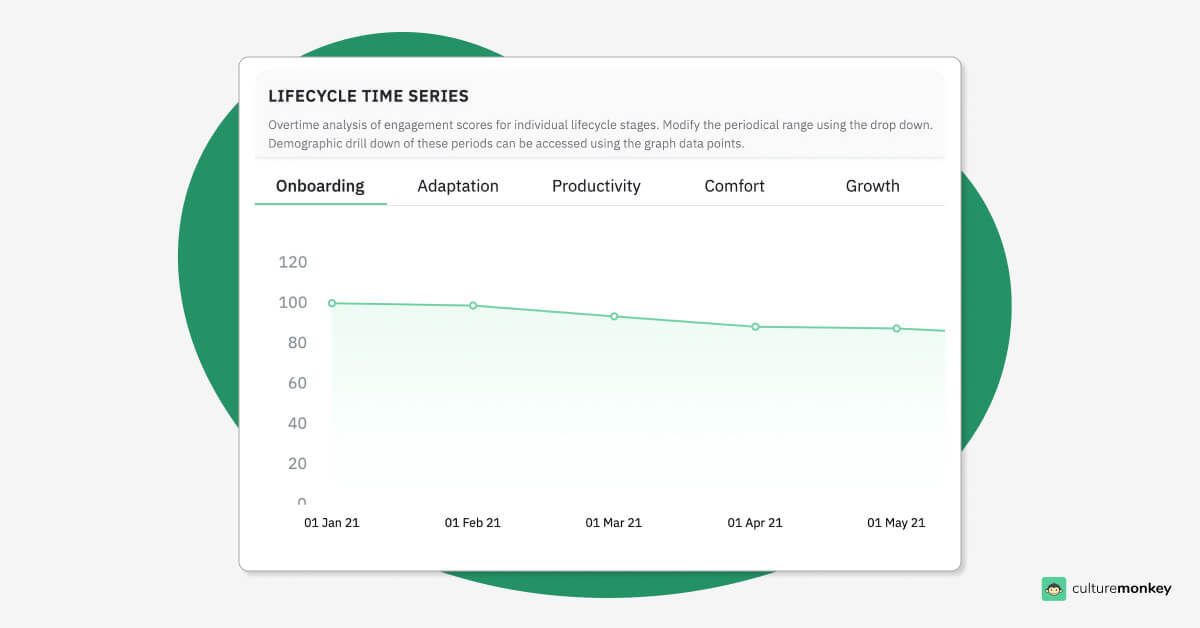
- Dynamic pulse surveys for proactive retention: Collect feedback at intervals from 7 days to 6 months with pulse surveys. Quickly address problem areas and empower managers to resolve issues before resignations occur. Ensure employees feel heard with consistent follow-through on feedback.
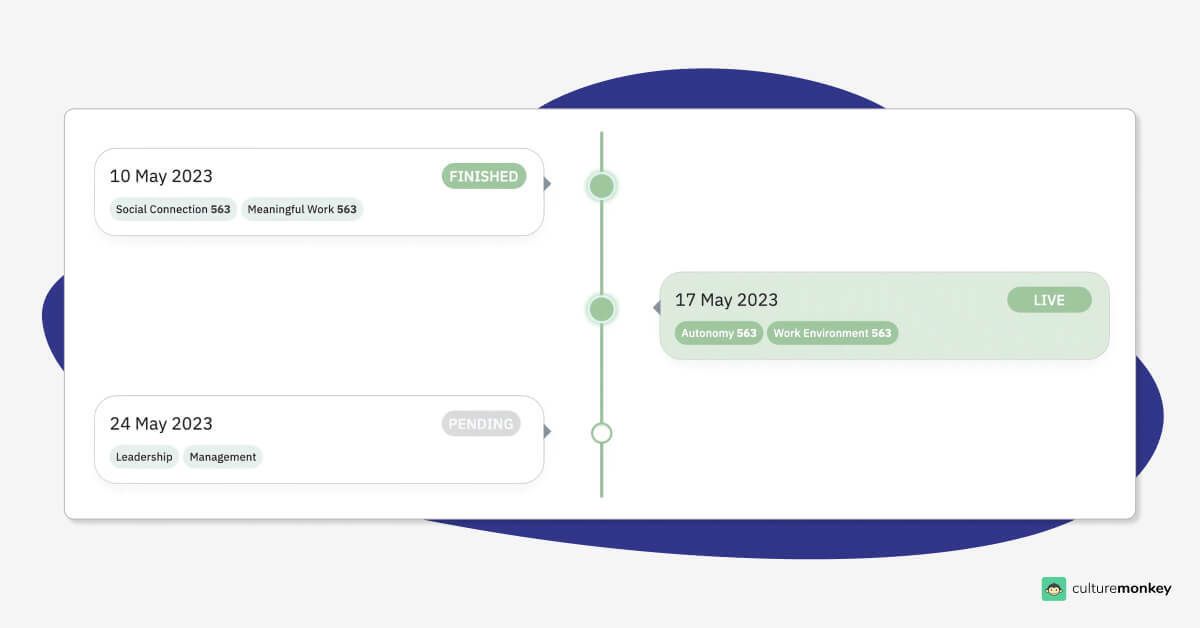
- Detailed heatmaps for improved retention: Generate heatmaps highlighting high and low engagement drivers. Pinpoint issues, track progress across time, and enhance retention rates with actionable insights. Use heatmaps to align organizational strategies with employee needs.
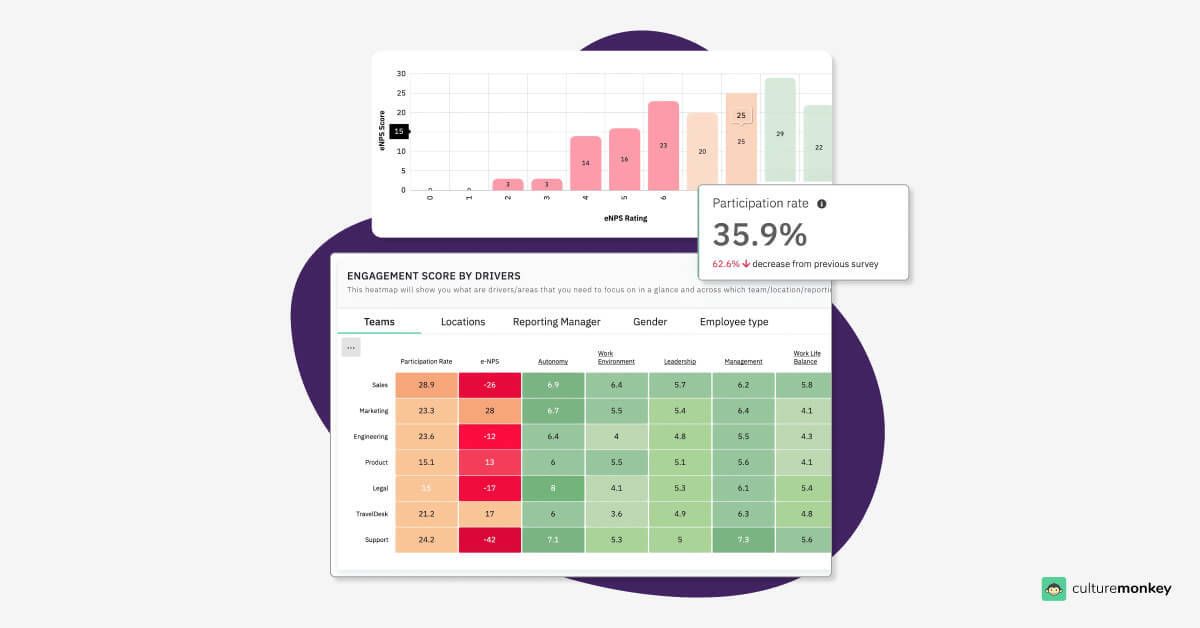
- Anonymous feedback for effective action: Allow employees to share concerns anonymously and address them effectively. Initiate 1-on-1 chats, create team solutions, and resolve issues to improve retention and employee experiences. Build trust by acting on feedback transparently and consistently.
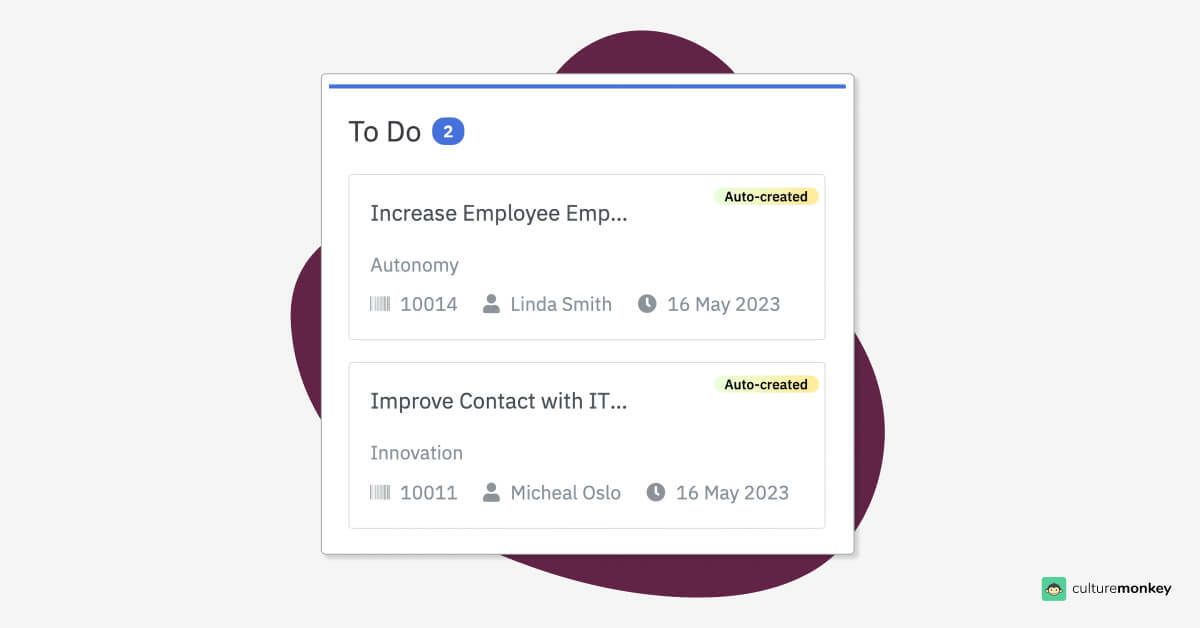
Conclusion
Employee retention software has emerged as a powerful ally in this endeavor, offering insights, predictive analytics, and tools to tackle attrition head-on. By understanding the factors that drive your employees to stay and addressing their concerns proactively, you can create a workplace where loyalty and engagement flourish.
But it doesn't stop here. If you're looking to take your employee retention strategies to the next level, consider CultureMonkey.
With CultureMonkey, you can delve even deeper into your company's culture, gather employee feedback, and drive positive changes that ease your employee retention issues, and improve job satisfaction.
Summary
Employee feedback loops are vital for enhancing engagement and retention. By continuously collecting, analyzing, and acting on employee insights, organizations can identify areas for improvement and implement necessary changes.
This iterative process fosters open communication, builds trust, and empowers employees to contribute to the company's success. Effective feedback loops lead to increased job satisfaction, higher productivity, and reduced turnover, ultimately driving organizational growth and stability.
FAQs
1. Why is retaining employees difficult?
Retaining employees can be challenging due to various factors such as increased job opportunities, evolving career aspirations, and changing market dynamics. Additionally, inadequate employee engagement, lack of growth opportunities, and ineffective leadership can contribute to higher turnover rates. Competition from rival companies, economic uncertainties, and cultural mismatches between employees and the organization can also complicate employee retention efforts.
2. How does company culture impact talent retention?
Company culture significantly influences talent retention by shaping employees' sense of belonging, satisfaction, and engagement. A positive and inclusive culture that values transparency, collaboration, and recognition fosters employee loyalty and commitment to the organization, reducing turnover rates. A strong company culture promotes a sense of purpose and shared values among employees, creating a cohesive and supportive work environment that encourages long-term retention.
3. What role does compensation play in retaining employees?
Compensation plays a crucial role in retaining employees by recognizing their contributions and providing financial security. Competitive salaries, performance-based bonuses, and comprehensive benefits packages demonstrate an organization's appreciation for employees' efforts, enhancing job satisfaction and retention. Fair and equitable compensation practices not only attract top talent but also reinforce employees' sense of value and worth.
4. How does work-life balance influence talent retention?
Work-life balance is essential for talent retention as it contributes to employees' overall well-being and job satisfaction. Organizations that prioritize work-life balance through flexible scheduling, remote work options, and wellness programs demonstrate a commitment to employees' personal and professional needs, reducing burnout and turnover. Promoting work-life balance fosters a positive organizational culture, enhances morale, and improves productivity.
5. How does providing flexible work options affect talent retention?
Providing flexible work options, such as telecommuting or flexible hours, can positively impact talent retention by accommodating employees' diverse needs and preferences. Flexible work arrangements promote work-life balance, increase job satisfaction, and improve retention rates by empowering employees to manage their schedules effectively. Offering flexible work options demonstrates trust in employees' abilities to manage their responsibilities effectively.
6. What impact does onboarding have on talent retention?
Effective onboarding processes are critical for talent retention as they set the foundation for employee success and satisfaction. Well-planned onboarding programs provide clarity, support, and resources to new hires, helping them integrate into the organization seamlessly and reducing turnover by fostering engagement and confidence in their roles. Comprehensive onboarding programs facilitate early connections with colleagues and leaders.
7. How can employee surveys help in retention?
Employee surveys provide valuable insights into employees' experiences, perceptions, and needs, helping organizations identify areas for improvement and address potential retention challenges. By soliciting feedback through surveys, organizations can identify factors influencing turnover, prioritize retention efforts, and implement targeted interventions to enhance employee satisfaction and loyalty.
8. What is the connection between employee engagement and retention?
Employee engagement is closely linked to retention as engaged employees are more likely to be satisfied, committed, and loyal to the organization. Organizations with high levels of employee engagement experience lower turnover rates, as engaged employees are emotionally invested in their work, motivated to perform at their best, and less likely to seek opportunities elsewhere.




